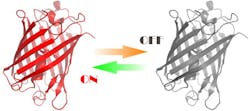Proteins controllable by orange and green light to study processes in living cells
A team of researchers at the Russian Academy of Sciences (Moscow, Russia) has developed fluorescent proteins that can be controlled by orange and green light, which will help to study processes in living cells.
Fluorescent proteins emit intense visible light with wavelengths ranging from 390 to 700 nm—their optical properties can therefore can be controlled with light. Switchable (the ability to be turned on or off with light) fluorescent proteins are widely used in a new group of methods called superresolution microscopy (nanoscopy), which allow imaging of extremely detailed intracellular structures. Scientists usually use blue or violet irradiation for this type of microscopy, which is very toxic for cells because it disrupts their normal physiology and can even cause death.
By creating photoswitchable fluorescent proteins with optical properties that can be controlled using green and orange light rather than blue-violet radiation, there is minimal harm to cells, explains Aleksandr Mishin, Ph.D., senior researcher of the Shemyakin-Ovchinnikov Institute of Bioorganic Chemistry of the Russian Academy of Sciences, who headed up the Russian Science Foundation (RSF)-funded project.
To create such fluorescent proteins, the scientists altered them by directed and random mutagenesis using a method called polymerase chain reaction (PCR). After that, the scientists cloned proteins and selected the best-performing ones using a microscope. They then analyzed the results of experiments carried out by other biologists and found out how the microenvironment of the chromophore (the aromatic amino acid residue responsible for light absorption in the protein) must be altered to make it capable of photoswitching.
However, the expected outcome does have its side effects: for instance, the brightness of the protein is reduced. Now, the researchers use random mutagenesis to find additional mutations, which compensate for side effects while preserving the target mutation.
A 3D model of the developed protein is shown. (Image credit: Aleksandr Mishin)
The proteins developed are called reporter proteins, as they act as "spies" within cells. They are attached to other proteins, which can then be traced in a living cell. The detailed information obtained thereby can be used in basic science or biomedical research. For instance, tumor cells in cancer patients exhibit dramatic disturbances of cell mobility and dynamic structural changes in the cytoskeleton, a carcass in the cytoplasm of a living cell. Meanwhile, the investigation of these processes in living cells by nanoscopy is difficult because of the overly intense irradiation of samples, making it necessary to use methods that are less toxic for the organism.
The authors used their development to carry out RESOLFT superresolution microscopy. The proteins have an important feature: their photoswitching is very efficient, meaning that fluorescence can be switched on and off in milliseconds. This does not suit all microscopy methods—in some cases, the high speed will only be a nuisance. In RESOLFT, the on-off cycle is repeated many times for adjacent points that are scanned with laser beams. The better the switching time of a fluorescent tag, the faster the complete image can be obtained because photoswitching at each point requires less time.
"The fluorescent proteins we created will enable superresolution microscopy without harming the living cell, which opens up opportunities for studying dynamic processes within the cell," Mishin says.
Full details of the work appear in the journal Nature Methods.
BioOptics World Editors
We edited the content of this article, which was contributed by outside sources, to fit our style and substance requirements. (Editor’s Note: BioOptics World has folded as a brand and is now part of Laser Focus World, effective in 2022.)
